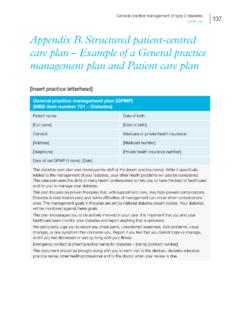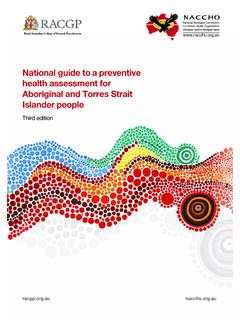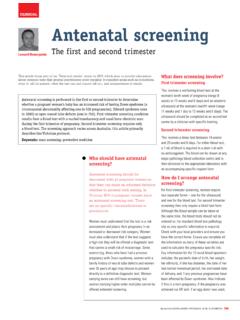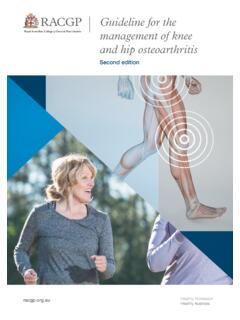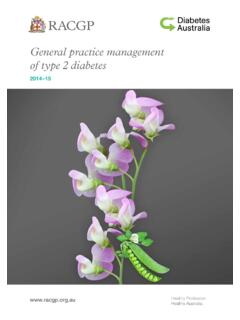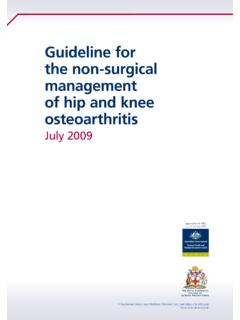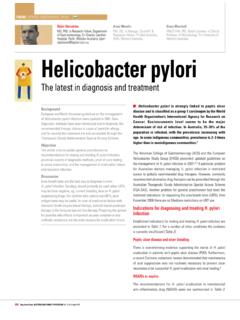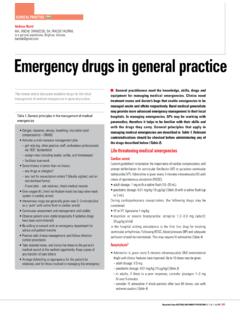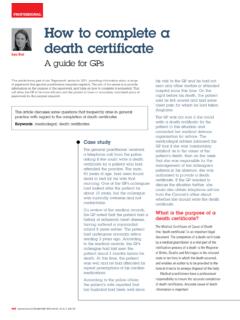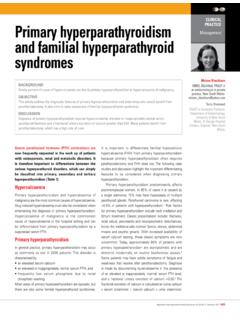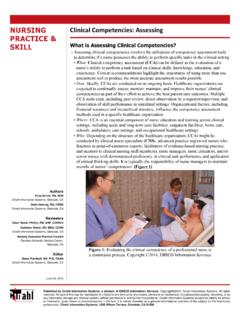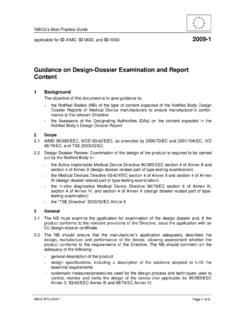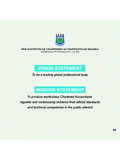Transcription of Child development Is my child normal? - RACGP
1 Child developmentChild developmentIs my Child normal? Milestones and red flags for referral Frank OberklaidKim DreverBackgroundDevelopmental problems in young children are common and have lifelong implications for health and wellbeing. Early detection of developmental problems provides an opportunity for early intervention to shift a Child s developmental trajectory and optimise their potential. ObjectiveThis article describes and recommends a broader concept of developmental surveillance that should replace the reliance on traditional methods of early detection such as milestone checklists, parent recall, developmental screening tests and clinical judgment. Discussion General practitioners and other professionals in regular contact with children and their families are ideally placed to monitor a Child s development , detect problems early and to intervene to optimise the Child s development and thus promote long term health and wellbeing.
2 Developmental surveillance involves eliciting parental concerns, performing skilled observations of the Child , and providing guidance on health and development issues that are relevant to the Child s age and the parents needs. Standardised tools are available to assist GPs to elicit parental concerns and guide clinical decision making. Keywords: Child development ; general practice; Child health services; developmental disabilities/screening Developmental problems in young children are more common than generally realised. Surveys suggest that up to 15% of children under the age of 5 years may have difficulties in one or more areas of development , including speech and language, motor, social-emotional and At the more severe end of the spectrum, developmental delay and disability will usually be detected at a relatively early stage, either because the Child has a significant delay that is detected by parents and/or a health professional, or because they are high risk (eg.)
3 Prematurity) and are monitored in a follow up neonatal intensive care unit , many children with mild to moderate problems are not detected until they are enrolled in structured educational settings such as kindergarten or school. In 2009, data collected nationwide on the developmental status of children entering their first year of school using the Australian Early development Index (AEDI) indicate that up to 24% of children have developmental vulnerabilities in one or more Parents are often the first to suspect a delay in development and will seek reassurance from a general practitioner or other health professional. In order to address this often challenging clinical scenario, GPs need to have an understanding of normal development , a strategy to detect the likelihood of problems, and a network of professionals to whom children can be referred when necessary and appropriate.
4 Normal developmentDevelopment in children progresses along pathways that are predictable, with specific observable developmental milestones achieved at certain ages (Table 1).3 However, there is considerable individual variability, so that a delay in achieving a particular milestone is not necessarily significant. However, the level of concern rises if the Child is late in achieving several factors to normal developmentBiological and environmental factors impact on the Child s development . Biological factors include prematurity and low birth weight, birth injury, vision and hearing impairment or chronic illness. Environmental risk factors can be in the immediate family 666 Reprinted from AustRAlIAn FAmIly PHysIcIAn Vol.
5 40, no. 9, sEPtEmBER 2011(low parental education, parental mental illness, social isolation, poverty and its consequences), and/or in the community (poor housing, poor quality services, lack of access to services). often risk factors cluster together, for example, poverty and its frequent associations with family and environmental risk factors (which represents the highest identifiable association with mild to moderate developmental delay).Methods of early detectionthere are a number of approaches to the early detection of developmental problems; these are not necessarily mutually exclusive, and most practitioners will often use a combination of concernBecause parents spend the most time with their children and see them under different circumstances, they can be expected to be the most reliable observers of their children s skills.
6 Indeed, there is considerable evidence that where parents have concerns about the Child s development , there is a reasonably high likelihood that the Child will be identified as having problems following It follows that health professionals should never ignore parental concerns. on the other hand, lack of parental concern about a Child s development may not mean that the Child s development is normal. Parents recall of developmental milestones is often inaccurate and biased toward the they tend to be more accurate when there is significant developmental delay present. Milestone checklistsmany professionals use milestone checklists as an aide memoire. Parents especially are reassured when their Child s development corresponds with developmental checklists (Table 1), which can be found in many parenting books.
7 Although development is generally predictable, it is sometimes uneven, so a Child developing normally may nevertheless be delayed in one or more milestones at a particular point in time but will subsequently catch up. It is likely that a reliance on developmental checklists alone will lead to the overidentification of children with delay. checklists are best utilised as an adjunct to early detection. Clinical judgmentAll health professionals rely to a large extent on their clinical judgment; informed by their training and clinical experience. It might be reasonably assumed that the more experience practitioners have, the more reliable their clinical judgment. While this may hold true for organic conditions, it has not been shown to be the case in the detection of developmental problems.
8 A seminal study undertaken many decades ago showed that paediatricians failed to identify almost 50% of children with mental retardation if they relied solely on clinical surprisingly, there was little correlation between the accuracy of detection and years of experience. While Table 1. Childhood milestones 0 5 years Communication and language milestonesAverage ageSocial smile6 weeksCooing3 monthsTurns to voice4 monthsBabbles6 9 months Mamma / Dadda (no meaning)8 9 months Mamma / Dadda (with meaning)10 18 monthsUnderstands several words1 yearSpeaks single words12 15 monthsPoints to body parts14 22 monthsAble to name one body part18 monthsCombines two words14 24 monthsSpeaks six or more words12 20 monthsAble to name five body parts2 yearsHas 50 word vocabulary2 yearsUses pronouns (me, you, I)2 yearsDevelopmental milestones (tasks)
9 Average ageFollows eyes past the midline6 weeksSmiles6 weeksBears weight on legs with support3 7 monthsSits with support4 6 monthsSits without support5 8 monthsCrawls6 9 monthsPuts everything into mouth4 8 monthsPulls to standing position6 10 monthsFirst tooth6 9 monthsWalks holding on7 13 monthsDrinks from cup10 15 monthsWaves goodbye8 12 monthsClimb stairs14 20 monthsTurns pages2 yearsScribbles1 2 yearsUses a spoon14 24 monthsPuts on clothing21 26 monthsButtons up30 42 monthsJumps on spot20 30 monthsRides a tricycle21 36 monthsBowel control18 months 4 yearsBladder control (day)8 months 4 yearsClear hand preference2 5 yearsAdapted with permission Oberklaid F, Kaminsky L. Your Child s health. Revised 4th edn. Melbourne: Hardie Grant Books, 2006 Reprinted from AustRAlIAn FAmIly PHysIcIAn Vol.
10 40, no. 9, sEPtEmBER 2011 667Is my Child normal? Milestones and red flags for referral FOCUSD evelopmental surveillancethis is a much broader concept than developmental screening. It is a longitudinal process that relies on repeated purposeful review of the Child and family. Developmental surveillance aims to not only detect delays early, but also identify and intervene into risk factors for Child It involves eliciting any parental concerns, performing skilled observations of children, and offering parents information and guidance on health and developmental issues relevant to the Child s age and parents the administration of a formal developmental screening test can be part of surveillance, but the results are interpreted in the context of all the activities described above.
